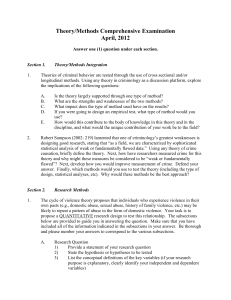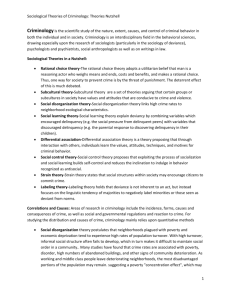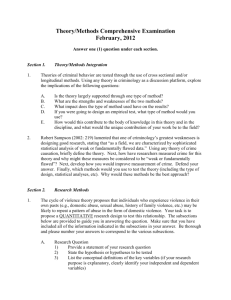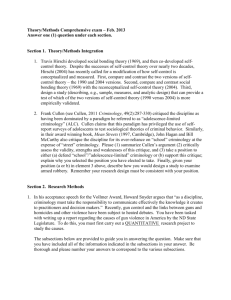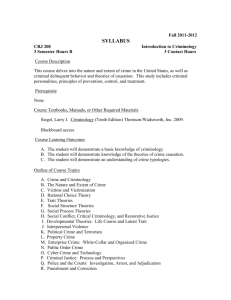Theory Syllabus Semester 2
advertisement
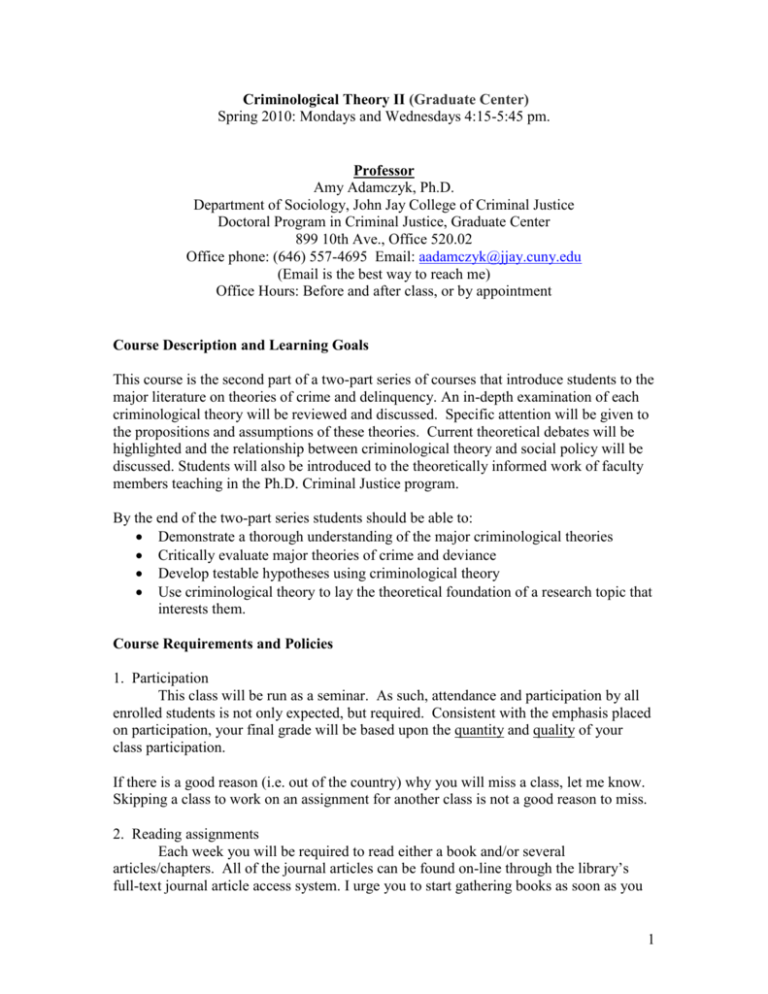
Criminological Theory II (Graduate Center) Spring 2010: Mondays and Wednesdays 4:15-5:45 pm. Professor Amy Adamczyk, Ph.D. Department of Sociology, John Jay College of Criminal Justice Doctoral Program in Criminal Justice, Graduate Center 899 10th Ave., Office 520.02 Office phone: (646) 557-4695 Email: aadamczyk@jjay.cuny.edu (Email is the best way to reach me) Office Hours: Before and after class, or by appointment Course Description and Learning Goals This course is the second part of a two-part series of courses that introduce students to the major literature on theories of crime and delinquency. An in-depth examination of each criminological theory will be reviewed and discussed. Specific attention will be given to the propositions and assumptions of these theories. Current theoretical debates will be highlighted and the relationship between criminological theory and social policy will be discussed. Students will also be introduced to the theoretically informed work of faculty members teaching in the Ph.D. Criminal Justice program. By the end of the two-part series students should be able to: Demonstrate a thorough understanding of the major criminological theories Critically evaluate major theories of crime and deviance Develop testable hypotheses using criminological theory Use criminological theory to lay the theoretical foundation of a research topic that interests them. Course Requirements and Policies 1. Participation This class will be run as a seminar. As such, attendance and participation by all enrolled students is not only expected, but required. Consistent with the emphasis placed on participation, your final grade will be based upon the quantity and quality of your class participation. If there is a good reason (i.e. out of the country) why you will miss a class, let me know. Skipping a class to work on an assignment for another class is not a good reason to miss. 2. Reading assignments Each week you will be required to read either a book and/or several articles/chapters. All of the journal articles can be found on-line through the library’s full-text journal article access system. I urge you to start gathering books as soon as you 1 can. I have indicated on the syllabus whether we will be reading the entire book, or selected chapters. 3. Discussion Facilitator Each of you will be required to lead some class sessions. On your selected days, you will be required to (1) craft a summary handout on the assigned class readings (to be distributed in class); (2) provide a 5 minute quick overview of the key ideas, the theory’s view of human nature, and how the theory is similar to one other theory we have discussed, and how it is different; (3) conduct a 20-30 minute presentation in which core propositions and implications are presented; and (4) lead a class discussion on the assigned readings. To aid in this process, presenters must draft around 5 discussion questions on a handout to be distributed in class. The purpose of these presentations is to get you comfortable talking about these ideas in front of other people, and to facilitate preparation for the first doctoral theory exam. Ideally, the handout would be between 2-3 pages and no more than 4 pages. After you sign up to facilitate a given class, you are responsible for making sure that there is someone there to facilitate the class that day. In other words, if something arises and you know you are going to miss the class you are supposed to facilitate, then you should contact me and work our arrangements with someone else to cover your class. 4. Speakers: We will have four professors come and talk with you about their work and how it relates to a given theoretical perspective. On days when we have a speaker all students are required to come prepared with some questions for the speaker either on the speaker’s work or the readings assigned for that day. These questions should be sophisticated and well-informed. 5. Presentation Each student will have to give a 15 minute presentation on his or her final paper. The presentations will incorporate PowerPoint slides and will be timed. Other students will be expected to ask questions and suggest ways of improving the research project. 6. Course Term Paper Each of you will be required to write a seminar paper on a topic of your choosing. The goals of this paper are: (1) to present a thorough review of the theory and research on your chosen topic and (2) to create a research project intended to expand on prior research and/or test previously untested theoretical propositions so that your project increases our understanding of the topic. The final paper can be in the form of a research proposal that would resemble a NSF grant proposal, or a research paper that at some point could be submitted to a journal. Please check with me to ensure that you have chosen an acceptable topic. If you are writing on the same topic in my class as you are in another class, both me and the other professor need to be informed and we will each need a copy of the final paper that you turn in for the other class. 2 This seminar paper should be 18 pages (double spaced) and should include the following elements: (a) a clear problem statement describing the issue(s) to be explored; (b) a review of the extant research literature on this topic, as well as an overview of the theoretical ideas that will be used to explain the hypothesized relationships (do not simply summarize the theory or the previous work in this area, rather develop from it your ideas); (c) a thorough description of the methodologies or analytic steps to be employed; (d) the results of your data analysis, if you are writing a research paper; and (e) a discussion of the importance of the findings or research topic (if you are writing a proposal), situating them within the existing literature and a discussion of important limitations of the project. This paper is worth 50% of your final grade. 7. Preparation for the exam: During the last two weeks of the semester we will begin review for the theory comprehensive exam. Each student will be asked to complete a question from previous exams and present it to the class. 8. Academic Integrity: Academic integrity is the pursuit of scholarly activity free from fraud and deception, and is an educational objective of this institution. Academic dishonesty includes, but is not limited to, cheating, plagiarizing, fabricating of information or citations, or facilitating acts of academic dishonesty of others, having unauthorized possession of examinations, submitting work of another person or previously used without informing the instructor, or tampering with the academic work of other students. Violations of academic integrity will result in failing this course and the filing of charges of Academic Misconduct. COUNT ON IT! 9. Email: To correspond with students I will be using the university email system. Every student has an account, which you can merge with other accounts (i.e. aol, yahoo). I will not be able to honor requests to contact students through other email accounts. 10. Eating in the classroom: You are welcome to drink beverages in the classroom, but please do not bring food (e.g. hamburgers), especially hot food that everyone can smell. If you bring in hot food, I will ask you to get rid of the food or leave the classroom. Grading distribution: Presentation=15% Class participation/discussion facilitator/Exam preparation=30% Final Paper=55% The syllabus is subject to change at the discretion of the instructor. 3 Course Outline Week 1: Introduction and Rational Choice Monday, February 1st Introduction Wednesday, February 3rd Hechter, Michael and Satoshi Kanazawa. 1997. “Sociological Rational Choice Theory.” Annual Review of Sociology 23: 191-214. Piliavin, I., Gartner, R., Thornton, C., and Matsueda, R.L. (1986) Crime, deterrence, and rational choice. American Sociological Review, 51:101-119. Piquero, Nicole Leeper, M. Lyn Exum, and Sally S. Simpson. 2005. “Integrating the Desire-for-Control and Rational Choice in a Corporate Crime Context.” Justice Quarterly, 22: 252-280. Week 2: Deterrence and Routine Activities Monday, February 8th Saltzman, L.E., Paternoster, R., Waldo, G.P., and Chiricos, T.G. (1982) Deterrent and experiential effects. Journal of Research in Crime and Delinquency, 19: 172-189. Stafford, M., and Warr, M. (1993) Reconceptualization of general and specific deterrence. Journal of Research in Crime and Delinquency, 30: 123-135. Wednesday, February 10th Felson, Marcus. (2002). Crime and Everyday Life. Thousand Oaks: Pine Forge. (Entire book) Week 3: Routine Activities Monday, February 15th No classes: University Scheduled (President’s Day) Wednesday, February 17th Osgood, D.W., Wilson, J.K, Bachman, J.G., O’Malley, P.M., & Johnston, L.D. (1996). Routine activities and individual deviant behavior. American Sociological Review, 61, 635-655. Smith, William R., Sharon Glave Frazee, and Elizabeth Davison. 2000. “Furthering the Integration of Routine Activities and Social Disorganization Theories: Small Units of Analysis and the Study of Street Robbery as a Diffusion Process.” Criminology 38:489-523. Thursday, February 18th (Classes for Monday take place) Guest Lecture: Professor Josh Freilich Freilich, J.D., & S.M. Chermak. (2009). Preventing deadly encounters between law enforcement and American far-rightists. Crime Prevention Studies 25: 141- 172. 4 - Also available online at the Center for Problem Oriented Policing website: http://www.popcenter.org/library/crimeprevention/volume_25/04FreilichChermak.pdf Wortley, R. (1997). Reconsidering the role of opportunity in situational crime prevention. In G. Newman, R. V. Clarke, & S. G. Shoham (Eds.), Rational Choice and Situational Crime Prevention (pp. 65–81). Aldershot: Ashgate. Wortley, R. (2001). A classification of techniques for controlling situational precipitators of crime. Security Journal, 14(4), 63–82. Students could also skim: Cornish, D., & Clarke, R. V. (2003). Opportunities, precipitators, and criminal decisions: A reply to Wortley’s critique of situational crime prevention. In M. J. Smith & D. B. Cornish (Guest Eds), Theory for practice in situational crime prevention. Crime prevention studies, 16, 41–96. Monsey, NY: Criminal Justice Press. Week 4: Biology and Crime Monday, February 22nd Rowe, David C. (2002). Biology and Crime. Los Angeles: Roxbury Publishing. (Chapters 1-3 and 6). Ward, D.A., and Tittle, C.R. (1994) IQ and delinquency: A test of two competing explanations. Journal of Quantitative Criminology, 10: 189-210. Wednesday, February 24th Caspi, A., Moffitt, T.E., Silva, P.A., Loeber, M.S., Krueger, R.F., and Schmutte, P.S. (1993) Are some people crime-prone? Replications of the personality-crime relationship across countries, genders, races, and methods. Criminology, 32: 163-196. Moffitt, T. (1993). Adolescence limited and life-course persistent antisocial behavior. Psychological Review, 100, 674-701. Rose, Nikolas. 2000. “The Biology of Culpability: Pathological Identity and Crime Control in a Biological Culture.” Theoretical Criminology 4: 5-34. Week 5: Functionalism and Symbolic Interaction Monday, March 1st Durkheim, Emile 1982 [1895]. The Rules of Sociological Method. (Chapter 1, 2, and 3, which should be Pp. 51-105 ). Free Press. Erikson, K.I. (1966). Wayward Puritans: A Study in the Sociology of Deviance. MA: Macmillan Publishing Company. (Chapter 1). Grabe, M.E. (1999). Television news magazines and functionalism. Critical Studies in Mass Communication. 16: 155-171. Wednesday, March 3rd Mead, George Herbert. (1962). Mind, Self and Society from the Standpoint of a Social Behaviorist. Ed. Charles W. Morris. Chicago: University of Chicago (Part 3: Pp.135222). 5 Gongaware, Timothy B. and Daniel Dotter. 2005. “Developing the Criminal Self: Mead’s Social Psychology and Sutherland’s Differential Association.” Sociological Spectrum 25: 379-402. Week 6: Symbolic Interaction and Labeling Monday, March 8th Guest Lecture: Professor David Green Green, D.A. (2008). When children kill children: Penal populism and political culture. Clarendon studies in criminology series. Oxford, UK: Oxford University Press. Wednesday, March 10th Lermert, Edwin M. (1967). Human Deviance, Social Problems and Social Control. N.J.: Prentice-Hall, Inc. (Chapter 3) Matsueda , R. L. (1992) Reflected appraisals, parental labeling, and delinquency: Specifying a symbolic interactionist theory. American Journal of Sociology. 97; 1577–611. Becker, H. 1963. Outsiders. New York: The Free Press. (Chapter 1). Week 7: Labeling, Shame, and Critical Monday, March 15th Wellford, C.F. (1975) Labeling theory and criminology: An assessment. Social Problems, 3: 332-345. Braithwaite, J. (1989). Crime, Shame and Reintegration. Cambridge University Press. (Chapters 4 and 5). Wednesday, March 17th Marx, K., & F. Engels. (1848). The Communist Manifesto. NY: Penguin. Week 8: Critical Monday, March 22nd Guest lecture: Jock Young Readings T.B.A. Wednesday, March 24th Lynch, M. and Groves, W.B. (1986). A Primer in Radical Criminology. Harrow and Heston. (Chapters 1-5) Week 9: Monday, March 29th No classes: University Scheduled (Spring Recess) Wednesday, March 31st No classes: University Scheduled (Spring Recess) Week 10: Women and Crime Monday, April 5th 6 No classes: University Scheduled (Spring Recess) Wednesday, April 7th Steffensmeier, Darrell, and Emilie A. Allan. (1996). “Gender and Crime: Toward a Gendered Theory of Female Offending.” Annual Review of Sociology. 22: 459487. Miller, J. and N.A. White. 2003. “Gender and Adolescent Relationship Violence: A contextual examination.” Criminology, 41(4): 1207-1248. Hagan, John, A. R. Gillis, and John Simpson. (1985). “The Class Structure of Gender and Delinquency: Toward a power-control theory of common delinquent behavior.” American Journal of Sociology, 90(6): 1151-1178. Week 11: Feminist Monday, April 12th Chesney-Lind, Meda. (1989). “Girls’ Crime and Woman’s Place: Toward a feminist model of female delinquency.” Crime and Delinquency, 35:5-29. Daly, Kathleen and Meda Chesney-Lind. 1988. “Feminism and Criminology.” Justice Quarterly 5(4): 497-538. Wednesday, April 14th Guest lecture: Valli Rajah Readings T.B.A. Week 12: Student Presentations Begin Monday, April 19th Student Presentations Wednesday, April 21st Student Presentations Week 13: Student Presentations Begin Cont. Monday, April 26th Student Presentations Wednesday, April 28th Student Presentations Week 14: Student Presentations and begin exam review Monday, May 3rd Student Presentations Wednesday, May 5th Review for Exam Week 15: Preparation/review for exam Monday, May 10th 7 Review for Exam Wednesday, May 12th Review for Exam Week 16: Last Class –Final Papers Due Monday, May 17th Review for Exam 8 DISCUSSION FACILITATOR FOR CRIMINOLOGY Professor Adamczyk 1. ORIENTATION: There are a lot of different kinds of presentations (i.e. teaching, professional presentations, job talks, presentations to the public) that you will do as you go through graduate school and once you complete your Ph.D. Each presentation requires different things. The summary presentations that you are doing in my class are most analogous to co-teaching. Hence, rather than demonstrate your public speaking abilities your goal is to try and get everyone to understand, remember, and think through the main ideas of the theory you are presenting. 2. TECHNIQUES: There are a lot of different teaching techniques you can use to help people understand and remember. To illustrate main ideas I use lots of examples (often about my family), but other people might use interesting stories, jokes, references to pop culture, etc. Think of interesting ways to make the ideas you are presenting come alive. 3. WHAT TO COVER: To the extent that you can try to interact with your audience and get a sense of what they do and do not understand. Everyone will have done the reading (if you have not done the reading, please refrain from participating in the discussion) and many may know these theories from other classes, but, of course, some will not. As we discuss the readings, note which ideas have been covered. Then when you give your summary, go quickly through the parts we have already discussed and spend more time on ideas and questions that you deem important, but have received little attention. 4. TIME FRAME: Sometimes you will have an entire hour to present your ideas and questions, other times (i.e. when we read an entire book or several articles) there will be much less time available. To the extent you can come prepared to work with whatever time is available. Often when you teach undergraduates you will not always know how much time you are going to be able to spend on a topic. Sometimes students grasp things very quickly, but other times they won’t. 5. YOUR NOTES: Since everyone will have done the reading and you are giving them a written summary of the main ideas, the time you spend presenting can be used to elaborate/explain/question the main ideas. The summaries you give to the class may be different than what you read from as you present. While you will have to do some summary of the main ideas you can also take this time to give your audience new information or interesting ideas to help them remember the main ideas. I was once told that when you teach undergraduates, you assign them your second favorite text book, and then lecture from your favorite textbook. Of course, I don’t want to see any text books in our class (read the primary sources first), but you may be able to provide some interesting background information or have some good elaborations of the main ideas. 9 6. LOOK UP: To the extent that you can try to make eye contact with your audience. One way to do this is to memorize parts of your summary, or give yourself just a few bullet points as a guide. As you prepare to take your exams, you will likely memorize some parts of the theories. Now might be a good time to start memorizing and it will make for a better presentation. I had a fellow colleague in graduate school that would put together his notes on what he was going to say to his undergraduates and then he would retype them 3-4 times so he would be able to go through them with ease. If I am presenting new material, I will definitely practice beforehand. 7. WHO HAS NOT SPOKEN: We have a big class and a lot of people want to talk (which I think is great). However, remember that some people are more aggressive than others. Some people will refrain from speaking because they have not done the reading, but some people are just shy or not used to speaking up. For this latter group try to create an environment where they will feel comfortable speaking. Also, you are welcome to call on people who have not had a chance to speak. I will also try to keep track of who has not spoken. If you tend to speak a lot in class and you see that other students want to speak, please give them a chance. If you think a given theory is particularly interesting and you want to keep the conversation going, consider going out for a drink with your classmates after class. While I am requiring everyone to complete all the readings, inevitably there will be days when this does not happen. For doctoral-level classes it is customary to simply tell the professor (if you are called on) that you did not do the reading. Because the class is so big, trying to respond to questions when you have not done the reading is inconsiderate to your fellow classmates. 8. CO-TEACHING: On the day you present we will be co-teaching together. Hence, if you can add anything to the main points I am trying to make, feel free to do it. I’ll also try to fill in your points. Remember our mutual goal is to get everyone to understand, remember, and think through the theories. As mentioned above, presenting at a professional meeting is different than presenting for colleagues. At the end of the semester everyone will give a 15-minutes presentation that is analogous to an American Society of Criminology presentation. 10

